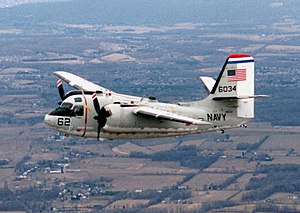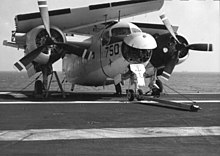
The Grumman C-2 Greyhound is a twin-engine, high-wing cargo aircraft designed to carry supplies, mail, and passengers to and from aircraft carriers of the United States Navy. Its primary mission is carrier onboard delivery (COD). The aircraft provides critical logistics support to carrier strike groups. The aircraft is mainly used to transport high-priority cargo such as jet engines and special stores, mail, and passengers between carriers and shore bases.

The Grumman S-2 Tracker was the first purpose-built, single airframe anti-submarine warfare (ASW) aircraft to enter service with the United States Navy. Designed and initially built by Grumman, the Tracker was of conventional design — propeller-driven with twin radial engines, a high wing that could be folded for storage on aircraft carriers, and tricycle undercarriage. The type was exported to a number of navies around the world. Introduced in 1952, the Tracker and its E-1 Tracer derivative saw service in the U.S. Navy until the mid-1970s, and its C-1 Trader derivative until the mid-1980s, with a few aircraft remaining in service with other air arms into the 21st century. Argentina and Brazil are the last countries to still use the Tracker.

The Grumman F11F/F-11 Tiger is a supersonic, single-seat carrier-based fighter aircraft designed and produced by the American aircraft manufacturer Grumman. For a time, it held the world altitude record of 76,939 feet (23,451 m), as well as being the first supersonic fighter to be produced by Grumman.

The North American FJ-2 and FJ-3 Fury are a series of swept-wing and carrier-capable fighters for the United States Navy and Marine Corps. The FJ-2 resulted from an effort to navalize the North American F-86 Sabre operated by the United States Air Force. These aircraft feature folding wings, and a longer nose landing strut designed to increase angle of attack upon launch and to accommodate a longer oleo to absorb the shock of hard landings on an aircraft carrier deck.

The Grumman E-1 Tracer was the first purpose-built airborne early warning aircraft used by the United States Navy. It was a derivative of the Grumman C-1 Trader and entered service in 1958. It was replaced by the more modern Grumman E-2 Hawkeye by the 1970s.

The Grumman F9F Panther is an early carrier-based jet fighter designed and produced by the American aircraft manufacturer Grumman. It was the first jet-powered fighter aircraft to see air-to-air combat with the United States Navy as well as being Grumman’s first jet fighter.

The Lockheed P-2 Neptune is a maritime patrol and anti-submarine warfare (ASW) aircraft. It was developed for the US Navy by Lockheed to replace the Lockheed PV-1 Ventura and PV-2 Harpoon, and was replaced in turn by the Lockheed P-3 Orion. Designed as a land-based aircraft, the Neptune never made a carrier landing, but a small number were converted and deployed as carrier-launched, stop-gap nuclear bombers that would have to land on shore or ditch. The type was successful in export, and saw service with several armed forces.

The Douglas SBD Dauntless is a World War II American naval scout plane and dive bomber that was manufactured by Douglas Aircraft from 1940 through 1944. The SBD was the United States Navy's main carrier-based scout/dive bomber from mid-1940 through mid-1944. The SBD was also flown by the United States Marine Corps, both from land air bases and aircraft carriers. The SBD is best remembered as the bomber that delivered the fatal blows to the Japanese carriers at the Battle of Midway in June 1942. The type earned its nickname "Slow But Deadly" during this period, along with a rarely-used accompanying nickname of "Furious D."

The North American T-2 Buckeye was the United States Navy's intermediate training aircraft, intended to introduce U.S. Navy and U.S. Marine Corps student naval aviators and student naval flight officers to jets. It entered service in 1959, beginning the replacement process of the Lockheed T2V SeaStar, and was itself replaced by the McDonnell Douglas T-45 Goshawk in 2008.

The Grumman F6F Hellcat is an American carrier-based fighter aircraft of World War II. Designed to replace the earlier F4F Wildcat and to counter the Japanese Mitsubishi A6M Zero, it was the United States Navy's dominant fighter in the second half of the Pacific War. In gaining that role, it prevailed over its faster competitor, the Vought F4U Corsair, which initially had problems with visibility and carrier landings.

The Grumman F7F Tigercat is a heavy fighter aircraft that served with the United States Navy (USN) and United States Marine Corps (USMC) from late in World War II until 1954. It was the first twin-engine fighter to be deployed by the USN. While the Tigercat was delivered too late to see combat in World War II, it saw action as a night fighter and attack aircraft during the Korean War.

The Grumman F8F Bearcat is an American single-engined, carrier-based fighter aircraft introduced in late World War II. It served during the mid-20th century in the United States Navy, the United States Marine Corps, and the air forces of other nations. It was Grumman Aircraft's last piston-engined fighter aircraft.
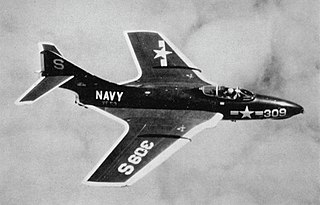
The Grumman F9F/F-9 Cougar is a carrier-based jet-powered fighter aircraft designed and produced by the American aircraft manufacturer Grumman.
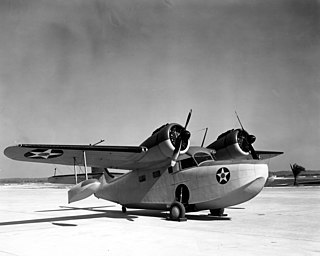
The Grumman G-21 Goose is an amphibious flying boat designed by Grumman to serve as an eight-seat "commuter" aircraft for businessmen in the Long Island area. The Goose was Grumman's first monoplane to fly, its first twin-engined aircraft, and its first aircraft to enter commercial airline service. During World War II, the Goose became an effective transport for the US military, as well as serving with many other air forces. During hostilities, the Goose took on an increasing number of combat and training roles.

The Grumman OV-1 Mohawk is an American armed military observation and attack aircraft that was designed for battlefield surveillance and light strike capabilities. It has a twin turboprop configuration, and carries two crew members in side-by-side seating. The Mohawk was intended to operate from short, unimproved runways in support of United States Army maneuver forces.

The Goodyear F2G Corsair, often referred to as the "Super Corsair", is a development by the Goodyear Aircraft Company of the Vought F4U Corsair fighter aircraft. The F2G was intended as a low-altitude interceptor and was equipped with a 28-cylinder, four-row Pratt & Whitney R-4360 air-cooled radial engine.

The Lockheed T2V SeaStar, later called the T-1 SeaStar, is a carrier-capable jet trainer for the United States Navy that entered service in May 1957. Developed from the Lockheed T-33, it was powered by one Allison J33 engine.

The Consolidated PB4Y-2 Privateer is an American World War II and Korean War era patrol bomber of the United States Navy derived from the Consolidated B-24 Liberator. The Navy had been using B-24s with only minor modifications as the PB4Y-1 Liberator, and along with maritime patrol Liberators used by RAF Coastal Command this type of patrol plane was proven successful. A fully navalised design was desired, and Consolidated developed a dedicated long-range patrol bomber in 1943, designated PB4Y-2 Privateer. In 1951, the type was redesignated P4Y-2 Privateer. A further designation change occurred in September 1962, when the remaining Navy Privateers were redesignated QP-4B.
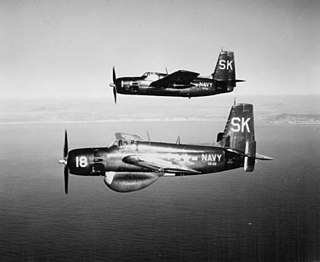
The Grumman AF Guardian is the first purpose-built anti-submarine warfare (ASW) carrier-based aircraft to enter service with the United States Navy. It consisted of two airframe variants, one for detection gear, the other for weapons. The Guardian remained in service until August 1955, when it was replaced by the twin-engined Grumman S-2 Tracker. The Guardian was the largest single-engine piston-powered carrier aircraft ever to see service.
